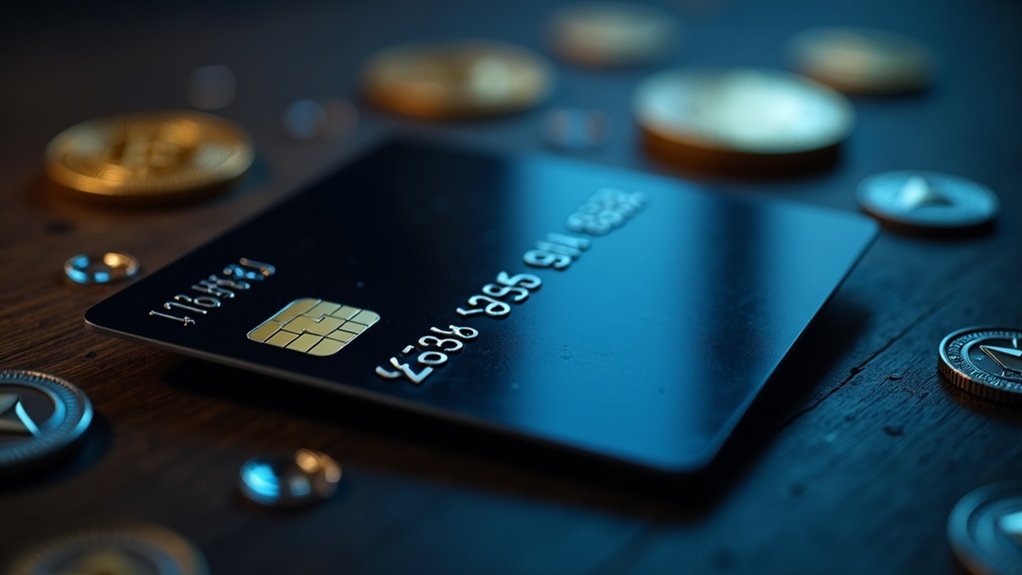Crypto credit cards function like traditional credit cards but award cryptocurrency instead of cash back. Users borrow fiat currency up to a limit, make purchases anywhere Visa or Mastercard are accepted, and earn crypto rewards—sometimes up to 5% back. These cards operate through exchanges or fintech companies, requiring normal payments to avoid interest and fees. They’re designed for people who want to accumulate digital assets without direct purchasing. The rewards fluctuate with market conditions, making them both exciting and potentially risky.
Imagine swiping your way to Bitcoin riches—or at least that’s the pitch. Crypto credit cards sound futuristic, but they’re actually pretty simple. They function just like regular credit cards, letting you borrow money up to a limit and pay it back later. The twist? You earn cryptocurrency instead of airline miles or cash back.
These cards don’t actually spend your crypto. Surprise! When you buy that overpriced latte, the transaction happens in good old dollars. The merchant never knows you’re part of the crypto scene. Your rewards, however, come in digital currencies—Bitcoin, Ethereum, whatever the card issuer offers.
Don’t confuse these with crypto debit cards. Different beast entirely. Debit cards pull directly from your existing crypto balance, converting your digital assets to fiat on the spot. Credit cards are borrowing tools that happen to pay rewards in crypto. Big difference.
Most crypto credit cards come from exchanges or fintech companies partnered with Visa or Mastercard. They work anywhere traditional cards are accepted. Swipe, chip, tap—same deal, different reward system. These crypto cards provide enhanced accessibility worldwide through major payment networks like Visa and Mastercard.
The rewards structure can be pretty sweet. Some cards offer tiered systems based on how much of their native token you stake. Crypto.com’s card, for instance, dangles up to 5% back in crypto. During bear market conditions, your rewards might be worth less but could gain value when prices recover. No expiration dates on these rewards either. They just sit in your linked wallet, potentially growing in value. Or tanking. That’s crypto for you.
Of course, there’s the usual credit card baggage. Miss a payment? Interest and late fees come knocking. Carry a balance? Those juicy crypto rewards might not offset the interest costs. The math doesn’t always work in your favor.
Who are these for? People who want to stack crypto without actively buying it. People comfortable with credit. People who pay their balances in full. Not ideal for the debt-averse or crypto skeptics. It’s just another way to blend traditional finance with the wild west of digital currency. These cards are designed specifically for accumulating crypto rather than facilitating spending in digital currencies.
Frequently Asked Questions
Are Crypto Credit Cards Available Internationally?
Crypto credit cards are available in over 150 countries worldwide.
China and India? Mostly excluded due to strict regulations.
Regional players dominate different markets: Gemini and Venmo in the US, Binance across Asia and the Middle East, Nexo globally.
Most cards link to Visa or Mastercard networks, making them widely accepted.
Real-time crypto-to-fiat conversion helps users spend internationally.
Regulatory hurdles exist though. Some countries just aren’t having it.
Apple Pay and Google Pay support enhances global usability.
What Happens if the Cryptocurrency Value Crashes?
If cryptocurrency crashes, it’s trouble.
Card rewards lose value immediately. Cash back that was worth $100 might suddenly be worth $50 or less. Ouch.
Cardholders with crypto-collateralized loans face margin calls or liquidation of their assets. The stats don’t lie – 60% of crypto investments are funded by debt.
When prices tank, many can’t repay these obligations. Result? Rising defaults, financial stress, and potentially frozen accounts on lending platforms.
Not pretty.
How Are Crypto Rewards Taxed?
Crypto rewards get taxed twice. Shocker.
First, they’re ordinary income when received—the IRS wants its cut right away at fair market value. Later, if you sell those rewards for more than their initial value, you’ll pay capital gains tax on the difference.
Hold them over a year? Lower tax rates. Under a year? Regular income rates apply.
Starting 2025, brokers must report everything anyway. No hiding from Uncle Sam in the crypto world.
Can I Transfer Existing Crypto to My Card Balance?
Yes. Users can absolutely transfer existing crypto to their card balance. The process is simple.
Send crypto from an external wallet to the card’s linked wallet address, or use in-app transfers if available. Internal transfers within the same platform? Usually instant and fee-free. External transfers? Expect blockchain network fees.
Once received, the crypto sits ready for conversion to fiat when purchases are made. Different cards, different rules though. Always check specific provider policies.
Do Crypto Credit Cards Offer Fraud Protection Like Traditional Cards?
Yes, crypto credit cards offer fraud protection similar to traditional cards. They use multi-layered authentication, tokenization, and real-time monitoring to catch suspicious activity.
The blockchain adds an extra security layer through cryptography. However, crypto-related protections are still evolving compared to traditional cards’ established frameworks.
Both face social engineering risks, but crypto transactions might have less mature consumer protections. AI-driven systems and KYC procedures help reduce fraud risks for both card types.









